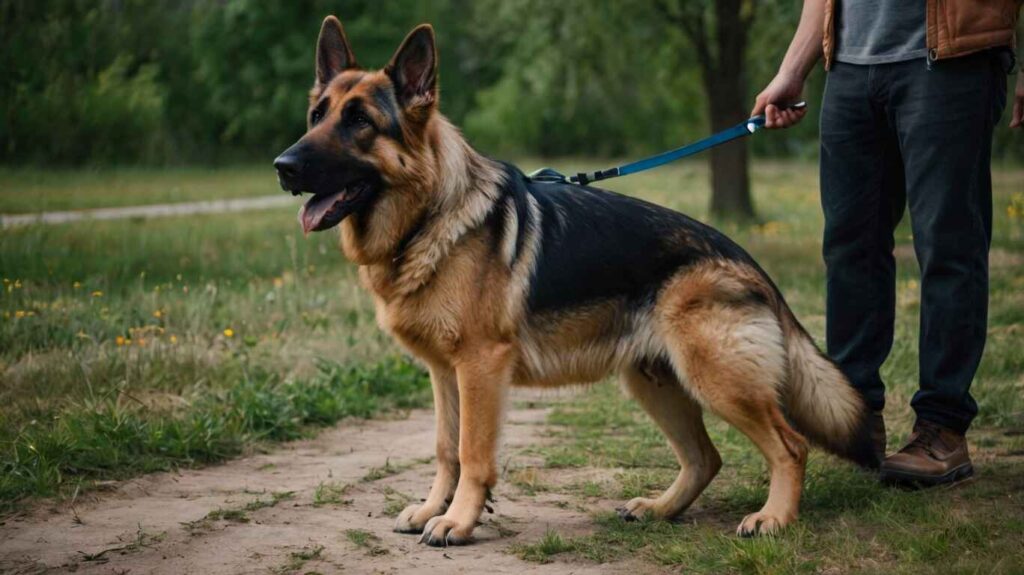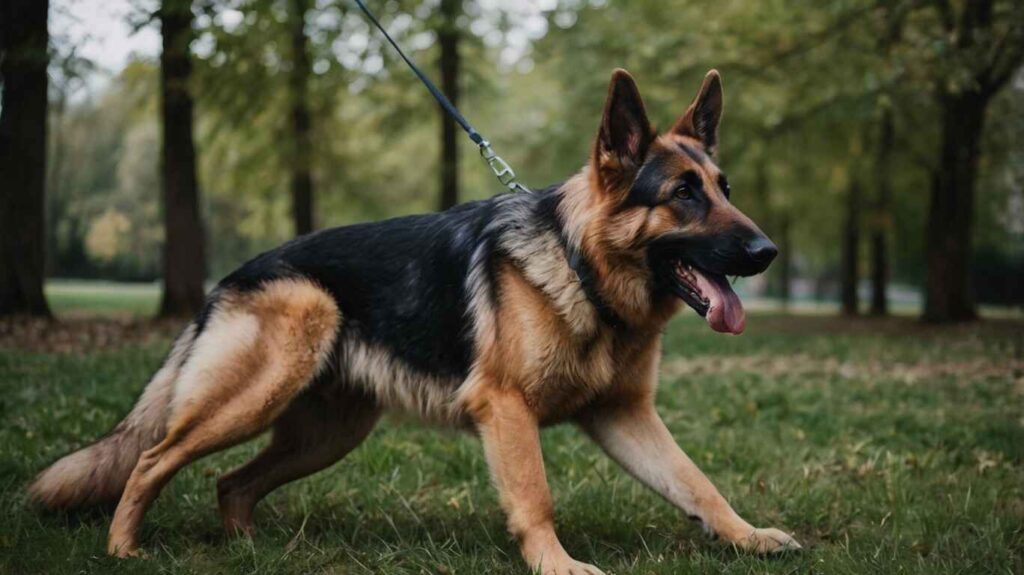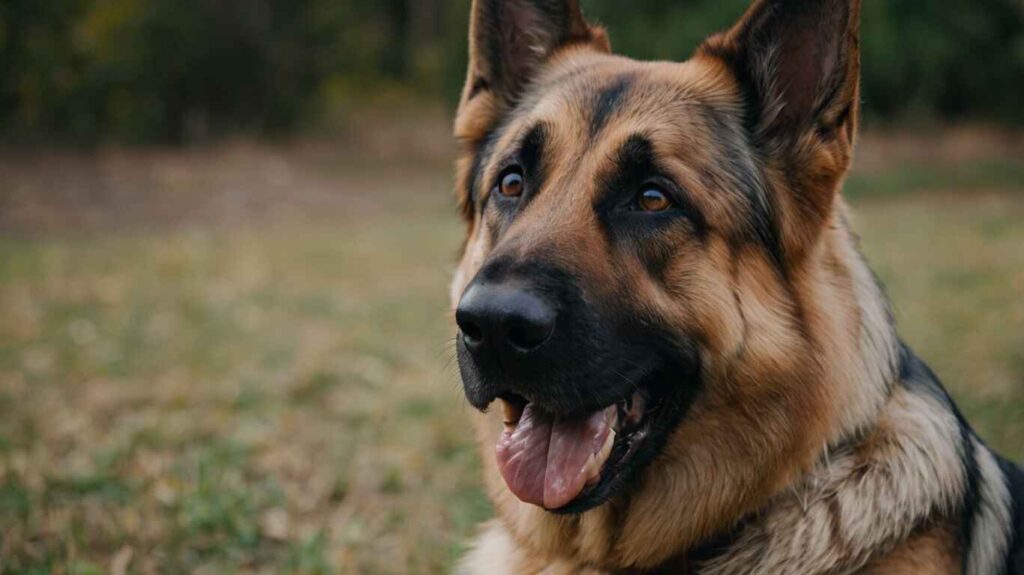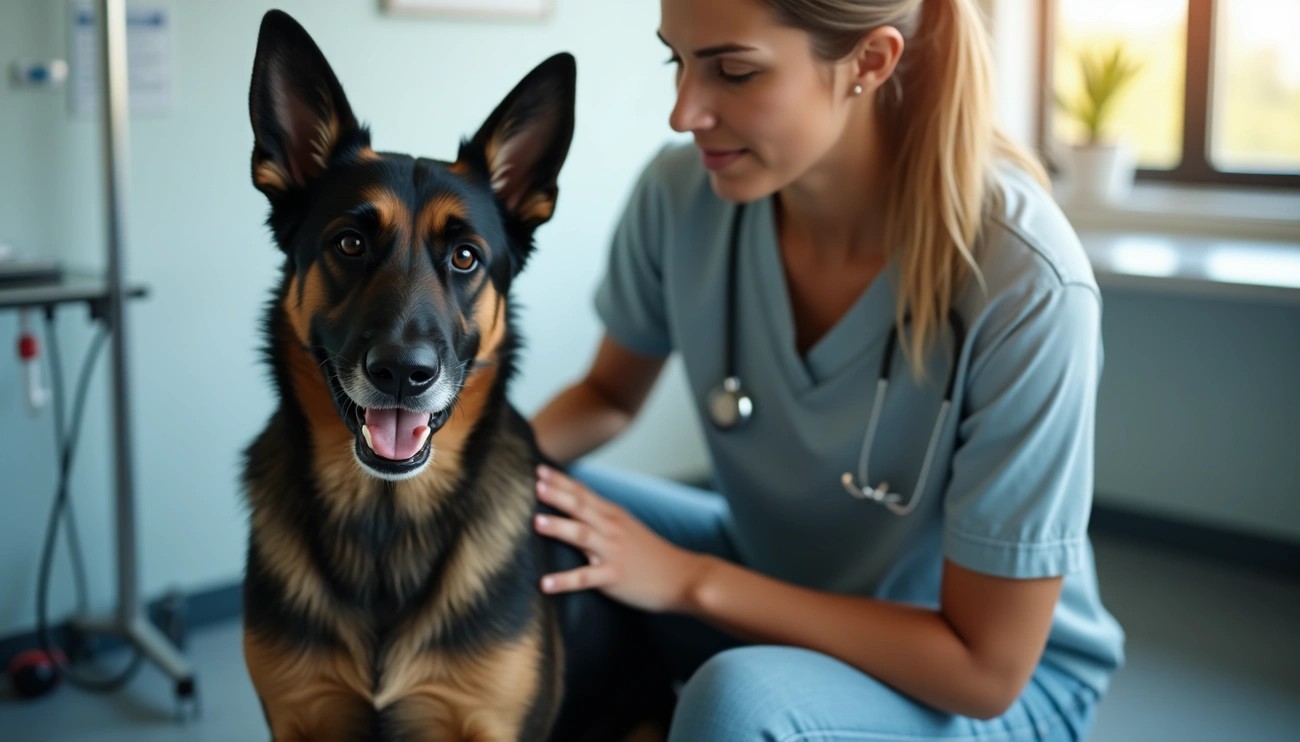German Shepherd health problems can impact the 10-12-year lifespan of these loyal dogs. You might have seen your furry buddy showing signs of pain or trouble moving, making you concerned and looking for answers.
These beloved dogs often get several health issues that affect how well they live. Hip and elbow dysplasia cause pain and make it hard to move, while dangerous conditions like bloat need a vet’s help right away. Also, degenerative myelopathy can weaken their back legs, showing up between the ages of 8 and 14. Many German Shepherds also deal with allergies that irritate their skin and make them uncomfortable, while others get cataracts as they get older.
Knowing about health problems that affect German Shepherds can help you notice early signs and do something about them. In this article, you’ll read true stories from other German Shepherd owners who’ve dealt with these issues, along with useful tips that could help your furry family member. If you’re new to owning a German Shepherd or have had them for a long time, this guide will give you info to take better care of your pet.
Hip Dysplasia

Hip dysplasia is a common health problem for German Shepherds. This painful condition happens when the hip joint grows causing a poor fit between the ball (femur head) and socket (acetabulum) that should create a smooth working joint. About 19% of German Shepherds have this condition.
Symptoms of Hip Dysplasia
Spotting the early signs of hip dysplasia in your German Shepherd can help you manage it better and improve your dog’s life. The symptoms might show up when your dog is just 4-6 months old, or they might start later in life
Look out for these main signs:
- Weird walking or moving – Many dogs with this problem start to “hop like bunnies,” using their back legs together when they run
- Trouble getting up – Dogs find it hard or struggle to stand up from lying down
- Less active – They don’t want to play, exercise, or do normal things as much
- Limping – Especially after they’ve been active or when it’s cold and wet outside
- Hurts when touched – Dogs show they’re uncomfortable or get angry when someone touches their hip area
- Don’t like stairs – They pause or won’t go up stairs, or get in and out of cars
- Muscle changes – Clear growth of shoulder muscles as they make up for weak back legs, along with muscle loss in the hind legs
At first, signs may come and go, but as time passes, they often stick around as the problem gets worse. Some pups show clear pain when they’re young, while others might not have any visible issues until they’re middle-aged or older
What causes Hip Dysplasia in German Shepherds
Hip dysplasia stems from a mix of genes and environment. Knowing these causes helps you take steps to prevent it.
Hip dysplasia involves many genes. German Shepherds whose parents have hip dysplasia are two times more likely to get it too. But sometimes, the problem can skip a generation, which is why careful breeding matters so much.
Besides genes, several things in a dog’s life can lead to hip dysplasia:
- Weight and growth rate – Extra pounds stress growing joints. Research indicates that overweight puppies had almost double the chance of hip dysplasia compared to normal-weight pups.
- Nutrition – Puppies with unlimited food access showed a much higher rate of hip dysplasia than those with controlled portions. High calcium intake during growth has a link to delayed skeletal maturation and increased risk of hip dysplasia.
- Exercise type and amount – Too much or the wrong exercise during growth can lead to hip dysplasia. Activities that impact the hips, like jumping or running on hard ground, may make the condition worse.
- Physical trauma – Hip injuries have the potential to set off dysplasia growth even in dogs that lack a strong genetic tendency.
A Dog Owner’s Experience with Hip Dysplasia
Riley’s case sheds light on how hip dysplasia affects dogs in real life. His owner first spotted subtle signs – Riley sometimes moved and had a bit of trouble getting up when lying down. As the problem got worse, Riley’s symptoms became obvious.
“He didn’t want to climb the stairs at bedtime anymore,” Riley’s owner said. “If you know German Shepherds, you know they always want to be near their family.” What stood out was how Riley acted during their usual playtime in the field – he wouldn’t run or play with their other dog, but just walk close to his owner.
X-rays confirmed the diagnosis, leaving Riley’s owners to make tough choices about treatment. The specialist laid out three options: long-term pain meds (which might harm the liver), complete hip replacement (priced at $5,000-$5,300 per hip), or FHO surgery.
Cali’s owner went through something similar with their 8-month-old German Shepherd. When the vet checked the dog’s bones, they found hip dysplasia in both hips, with worrying damage. They also had to think hard about whether to do surgery.
These tales show how hip dysplasia can hit owners and their dear German Shepherds hard, both financially and emotionally.
How to manage or prevent Hip Dysplasia
Although we can’t always stop hip dysplasia, we can take steps to lower the risk and handle the symptoms better.
To prevent it:
- Smart breeding – Pick puppies from breeders who check for hip dysplasia using OFA or PennHip tests
- Careful feeding – Give the right large-breed puppy food to avoid too much growth
- Balanced exercise – Take many short walks instead of one long one; don’t let puppies jump or run on hard ground while they’re growing
- Early checks – Think about getting your puppy’s hips x-rayed to take the right steps to prevent problems
To manage it:
Ways that don’t need surgery include:
- Weight management – Keeping your dog slim puts less stress on affected joints
- Physical therapy – Swimming and controlled exercise help make supporting muscles stronger
- Joint supplements – Glucosamine, chondroitin, MSM, and omega-3 fatty acids can boost joint health
- Medication – NSAIDs and other pain meds can give relief when needed
- Comfort measures – Warm beds and floors that aren’t slippery help cut down on pain and stop falls
Doctors might suggest surgery for bad cases:
- Total Hip Replacement (THR) – Gives great results but costs $5,000-$5,300 per hip
- Femoral Head Ostectomy (FHO) – A cheaper option that takes out the femoral head, letting scar tissue form a “fake” joint
- Triple Pelvic Osteotomy (TPO) – Works best for young dogs (6-12 months) with no signs of osteoarthritis
When vets spot hip dysplasia manage it well, and sometimes do surgery, many German Shepherds with this tough condition can enjoy active comfy lives.
Bloat (Gastric Dilatation-Volvulus)

Bloat poses one of the most critical health threats German Shepherds encounter, even with treatment if not spotted early enough. Unlike some conditions that develop gastric dilatation-volvulus (GDV) hit and worsen fast, turning within hours without quick action. mortality rates reaching 50%
Symptoms of Bloat in German Shepherds
Spotting bloat symptoms can mean the difference between life and death for your German Shepherd. Because this condition gets worse so fast, knowing these warning signs is key:
- Bloated belly – A puffy or big tummy, often firm and taut like a drum
- Dry heaving – Repeated tries to throw up that yield little to nothing, except maybe white froth
- Uneasy and worried – Can’t relax, walking around, crying, or always shifting positions
- Too much spit – A Clear increase in saliva output above regular amounts
- Strained breathing – Trouble taking breaths as the growing stomach pushes on the chest muscles
- Hurting reactions – Discomfort when you touch the belly, look at, or nip their stomach
- White gums – Gums looking colorless or light due to reduced blood flow
- Quick pulse – Speeded-up heart rate as the body tries to make up for less blood moving around
- Trouble standing or fainting – As the condition worsens, dogs might struggle to stay on their feet or pass out
The most concerning part of bloat is how it gets worse – your healthy dog can go from fine to ill in just 30-60 minutes. This short timeline means you need to get vet help right away when you first notice any signs.
What causes Bloat in German Shepherds
We’re still not sure what causes bloat. Vets are still debating whether gas buildup makes the stomach twist or if twisting leads to gas buildup. But we do know several things that put German Shepherds at higher risk:
First, body structure has a big impact. German Shepherds have deep, narrow chests that let their stomachs move more, which makes their risk five to eight times higher than breeds with wider chests. Male dogs are twice as likely to get it as females, no matter if they’re fixed or not.
Beyond how they’re built, several lifestyle and environmental things add to the risk:
How dogs eat matters. Dogs that eat one big meal a day are twice as likely to get it as those that eat several smaller meals. Dogs that eat fast are five times more likely to get it than slow eaters. Food with soybean meal or oils/fats in the first four ingredients makes the risk four times higher.
Age and temperament also matter. Dogs between 7-12 years old face a higher risk, as do dogs that feel anxious or stressed. Dogs that are unhappy or scared have twice the chance of getting bloat.
Genes play a big part too. Dogs whose family members (parents, brothers, sisters, or children) have had bloat are more likely to get it.
Real owner experience with Bloat
Max’s story shows how scary bloat can be for German Shepherds. His owner, Sarah, saw him get restless one night, walking around their living room. In just a few minutes, he started to gag but nothing came out. What worried her most was how fast his belly grew, becoming very swollen.
After spotting these red flags from her study on German Shepherd health problems, Sarah rushed Max to the emergency vet right away. Because she acted fast, vets managed to relieve the pressure in Max’s stomach before it flipped. They then did urgent surgery, which included gastropexy (tacking the stomach) to stop it from happening again.
“I can’t stress enough how fast this all went down,” Sarah said. “Max was fine on our evening walk, but within an hour, he was struggling to survive. If I hadn’t known what to look for, I might’ve waited until morning—and that would’ve been too late.”
Another striking case involved Woody, whose bloat episode happened during a stressful house move in a thunderstorm. His stress increased because of unexpected treats he wasn’t used to. This story teaches us to keep an eye on German Shepherds when things get hectic.
How to manage or prevent Bloat
While you can’t always stop bloat, you can lower your German Shepherd’s risk through several proven methods:
Feeding habits have a huge impact. Give smaller meals 2-3 times a day instead of one big meal. Use bowls that slow down eating to stop gulping. Unlike old advice, new studies say not to use raised food bowls for breeds with deep chests. Cut down on water right before and after meals, and wait at least an hour between feeding and exercise.
Dealing with stress is key to prevention. Set up quiet feeding areas, keep dogs apart at mealtimes if needed, and watch during stressful times like moving, thunderstorms, or stays at kennels.
Surgery to prevent bloat provides the strongest protection. Gastropexy, which involves attaching the stomach to the belly wall, stops it from twisting. Many vets suggest this operation for dogs at high risk. They often do it during spaying or neutering to cut down on expenses and healing time.
If you think your dog has bloat, call your vet or an emergency clinic right away—don’t wait or try to fix it at home. Treatment includes IV fluids, pain meds, emptying the stomach, and surgery to fix the twist and do a gastropexy. When caught, 90-95% of dogs survive, but this number drops fast if treatment is delayed.
By staying alert, taking steps to prevent issues, and acting when necessary, you can keep your German Shepherd safe from this scary but controllable health problem
Degenerative Myelopathy

Degenerative myelopathy has an impact on about 2% of all German Shepherds, making it a major worry for people who own this breed. This ongoing nerve disease affects the spinal cord, causing a slow loss of muscle control and eventual paralysis that starts in middle to older age.
Symptoms of Degenerative Myelopathy
The first signs of degenerative myelopathy can be hard to spot, and people often mistake them for normal aging or other health issues. Spotting these early warning signs helps to act faster:
- Weak hind limbs – The first and most telling sign starts around 8-9 years old
- Paws that drag or scuff – Dogs often wear their toenails down because they drag their feet
- Knuckling – The dog steps on the tops of its paws when it turns
- Hindquarters that sway – You can see clear wobbling when the dog stands still
- Hard time getting up – The dog struggles to rise from a lying position
- Easy falls – The dog loses balance if pushed from the side
- Hind legs that cross – An odd walking pattern where legs step over each other
As the disease gets worse over 6-12 months, symptoms become more severe, with full paralysis developing in the back end. It’s worth noting that degenerative myelopathy doesn’t cause pain, but it has a big impact on mobility, which reduces quality of life.
In later stages, the disease moves up the spinal cord, affecting how well the bladder and bowels work. Also, the front legs might end up affected if the condition keeps getting worse.
What causes Degenerative Myelopathy in German Shepherds
At its heart, degenerative myelopathy stems from a . This change causes nerve fibers in the spinal cord to break down and disappear, which makes the nervous system fall apart as time goes on. mutation in the superoxide dismutase (SOD1) gene
The way it’s passed down is autosomal recessive with incomplete penetrance. In simple terms, this means:
- Dogs need two abnormal gene copies (DM/DM) to face a high risk of getting the disease
- Dogs with one normal gene and one changed gene (carriers) can pass the condition to their puppies if they mate with another carrier
- Not all dogs with two changed copies will show signs of illness – other genes and things in their surroundings affect how the disease shows up
Several breeds carry this change, with German Shepherds being one of the most affected. New studies suggest DM might come from complex interactions, including a possible gene called SP110 that raises the risk when it’s there along with the SOD1 change.
The disease affects dogs between 8-14 years old, though in rare cases, it has shown up in dogs as young as 6 months.
Real owner experience with Degenerative Myelopathy
Golo’s story shows the difficulties and opportunities of living with DM. At 12 years old, he fell during a walk, unable to move his left hind leg. The owner remembers: “He could not walk at all unless being supported. He could not even stand to pee… we had to lift him and press the stomach to empty his bladder”.
With no effective vet solutions available, Golo’s owner looked into treatments and created a full approach including medicines, supplements, diet changes, and most importantly, lots of daily exercise. Despite common advice to avoid stairs, Golo’s owner found that watching stair climbing helped keep his strength.
The owner’s determined approach had a positive impact. “After a month, he felt much better and we went back to our usual long walks on the beach and in the forest,” the owner says. Golo lived for two more years after his diagnosis, which surprised everyone. He stayed mobile until he died at over 14 years old.
Bruce’s owner also found that their dog beat the odds. “I thought he wouldn’t be with us past this time last year. Bruce was stubborn, independent, and didn’t like too much physical touch, so I was sure his battle with Degenerative Myelopathy would be quick.” But Bruce adjusted well to help devices and kept enjoying adventures even though he couldn’t use his back legs at all.
How to manage or prevent Degenerative Myelopathy
No cure exists for DM, but several approaches can make life better and slow down its progress:
Physical Therapy and Exercise: Research shows that dogs that get intense physical therapy keep moving much longer than those with little or no rehab. Regular controlled workouts help keep muscles strong and working as long as possible.
Assistive Devices:
- Dog wheelchairs to keep them active
- Booties to shield paws from scraping and harm
- Harnesses or slings to help with walking and standing
- Non-slip floors to stop falls and injuries
Home Adaptations:
- Ramps to help dogs climb steps or get into furniture/vehicles
- Soft bedding to stop pressure sores
- Rugs or yoga mats on slick floors for a better grip
Genetic Testing and Prevention: The Orthopedic Foundation for Animals offers genetic tests to find dogs with the mutation. These tests let breeders make smart choices about breeding carriers:
- Dogs that test “clear” have two normal copies of the gene
- Dogs that test as “carriers” have one normal and one changed copy
- Dogs that test “at-risk” have two changed copies
For old breeds where the mutation is common, experts say to treat test results as just one of many things to think about when deciding to breed. They don’t suggest cutting out all carriers and at-risk dogs from breeding programs.
First and foremost, keeping a good quality of life needs careful attention and the ability to change. As Bruce’s owner points out, “Don’t give up on the hard ones, they do give you so much more in return”.
Allergies and Skin Conditions

German Shepherd owners often face allergy and skin problems with their dogs at some point. These sensitive dogs are among the breeds most likely to have allergic reactions. These reactions show up as uncomfortable and painful skin issues that have an impact on their quality of life.
Symptoms of Allergies in German Shepherds
Allergy signs in German Shepherds appear on the skin and ears, but they can also affect other parts of the body. Keep an eye out for these warning signs:
- Lots of scratching or biting certain spots, often shaking the head
- Inflamed skin with redness, rashes, and sore areas
- Bald patches, plus dry, flaky, or oily skin
- Ear troubles like redness, smell, or frequent infections
- Rubbing the face on furniture, carpet, or grass
- Other infections that pop up from too much scratching
These signs show up on the face, ears, paws, sides, back end, legs, and belly. Ear problems need quick action because they can turn into painful infections if you ignore them.
What brings on Skin Allergies in German Shepherds
German Shepherds can get different kinds of allergies, each with its own triggers:
Environmental allergies (atopic dermatitis) top the list of common allergies. Pollen, grass, dust mites, and mold set them off. These allergies cause symptoms that come and go with the seasons or stick around all year, depending on what triggers them. Kids often start to show signs of these allergies between the ages of 1 and 3, and they tend to get worse as time goes on.
Food allergies are another big worry. Most people think grains are the main culprits, but that’s not true. Animal proteins like beef, chicken, and lamb are the foods that dogs are most likely to be allergic to. Dairy, eggs, and corn can also cause problems. Food allergies show up as skin issues, but they can mess with a dog’s stomach, too.
Some dogs are super sensitive to flea bites. This happens when they react to proteins in flea spit. It’s pretty wild, but even one tiny flea bite can make a sensitive dog itch like crazy and their skin get all inflamed.
Contact allergies occur when substances touch the skin, including cleaning products, certain plants, or even topical medications. These areas with less fur like the belly, armpits, and paw pads.
Real owner’s experience with Allergies
Groot’s story shows the tough road many German Shepherd owners travel with allergies. His owner first saw watery eyes when Groot was just three months old. After changing from cheap dog food to a premium brand, the eye issues went away, but other allergy symptoms stayed.
“We’ve been to many vets looking for answers,” Groot’s owner said. “We tried OTC allergy medications, but they didn’t work, and Apoquel helped for a short time.”
After a vet ruled out food allergies at first, another vet thought they might be the problem after all. Changing from chicken-based food to salmon and sweet potato helped Groot’s scaly skin, but he still itched. His owner now thinks outdoor things like grass and pollen add to the ongoing symptoms.
How to manage or prevent Allergies
Managing allergies in German Shepherds needs several steps:
For outdoor allergies, regular baths with the right shampoos help remove allergens from the coat. Shampoos that don’t cause allergies, without sulfates, and with things like tea tree oil or aloe vera can soothe itchy skin. Wiping your dog with a warm, damp cloth after time outside removes pollen and other allergens.
To identify problem foods for dogs with allergies, vets often suggest an elimination diet. This means feeding your dog a diet with few ingredients and new protein sources it hasn’t eaten before. You then add back potential allergens to see how your dog reacts.
Dogs with flea allergies need good, regular flea control. Even one flea can make an allergic dog very uncomfortable.
If home care doesn’t work well enough, your vet might give your dog medicine. This could be antihistamines, corticosteroids, or newer options like Apoquel or Cytopoint shots. In bad cases, seeing a vet or skin doctor for allergy tests and possible immunotherapy can help in the long run.
With careful study and the right care plans, most German Shepherds with allergies can feel much better and live happier lives.
Exocrine Pancreatic Insufficiency (EPI)

FAQs
Q1. What are the most common health issues in German Shepherds?
The most prevalent health concerns for German Shepherds include hip dysplasia, bloat (gastric dilatation-volvulus), degenerative myelopathy, allergies and skin conditions, and exocrine pancreatic insufficiency (EPI). Regular veterinary check-ups and awareness of symptoms can help catch these issues early.
Q2. How can I prevent hip dysplasia in my German Shepherd?
While hip dysplasia can’t always be prevented, you can reduce risk by choosing puppies from health-screened parents, maintaining a healthy weight, providing appropriate nutrition, and avoiding excessive exercise during growth. Early screening and controlled exercise can also help manage the condition.
Q3. What are the warning signs of bloat in German Shepherds?
Key symptoms of bloat include a visibly swollen abdomen, unsuccessful attempts to vomit, restlessness, excessive drooling, and labored breathing. This is a life-threatening emergency requiring immediate veterinary care. Feeding smaller meals and avoiding exercise right after eating can help reduce the risk.
Q4. How can I manage allergies in my German Shepherd?
Managing allergies often involves identifying and avoiding triggers, whether environmental or food-related. Regular bathing with appropriate shampoos, dietary changes, and consistent flea control can help. In some cases, medication or immunotherapy prescribed by a veterinarian may be necessary.
Q5. What is the life expectancy of a German Shepherd?
German Shepherds typically live between 10 and 12 years. However, with proper care, nutrition, regular exercise, and proactive health management, many can enjoy a good quality of life well into their senior years. Regular veterinary check-ups are crucial for addressing age-related health issues early.
